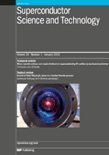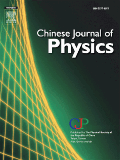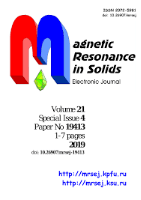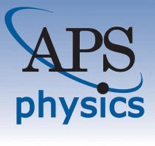
SUPERCONDUCTOR SCIENCE & TECHNOLOGY
Scope & Guideline
Exploring Innovations in Materials Science
Introduction
Aims and Scopes
- Superconducting Materials Development:
Research focused on the synthesis, characterization, and enhancement of various superconducting materials, including high-temperature superconductors (HTS) and iron-based superconductors. - Magnet Design and Applications:
Innovative designs of superconducting magnets and their applications in various fields such as medical imaging (MRI), particle accelerators, and energy storage systems. - Vortex Dynamics and Pinning Mechanisms:
Studies on vortex dynamics, including the understanding of vortex pinning mechanisms and their implications for the performance of superconductors in applied magnetic fields. - Quantum Computing and Electronics:
Exploration of superconducting materials and devices for quantum computing applications, including superconducting qubits and single-photon detectors. - Electromagnetic and Thermal Modeling:
Advanced modeling techniques to understand the electromagnetic and thermal behaviors of superconducting systems, which are crucial for optimizing performance and reliability. - Fault Current Limiters and Protection Systems:
Research on superconducting fault current limiters (SFCLs) and other protective devices to enhance the safety and efficiency of electrical systems.
Trending and Emerging
- Artificial Intelligence and Machine Learning in Superconductivity:
There is a growing trend towards integrating artificial intelligence (AI) and machine learning (ML) techniques to optimize superconducting materials and systems, as well as to analyze experimental data. - Advanced Coating and Fabrication Techniques:
Emerging research focuses on novel coating methods and fabrication techniques for improving the performance of superconducting materials, such as advanced deposition methods and hybrid structures. - Sustainability in Superconducting Technologies:
Research addressing the environmental impact of superconducting materials and processes, including recycling and the development of sustainable superconducting technologies. - Quantum Technologies and Superconductors:
An increasing emphasis on the role of superconductors in quantum technologies, particularly in the development of quantum computing and quantum communication systems. - Multifunctional Superconducting Devices:
The trend is moving towards the development of multifunctional superconducting devices that integrate various functionalities, such as sensing, computing, and energy storage.
Declining or Waning
- Low-Temperature Superconductors:
Research specifically focused on low-temperature superconductors seems to be declining as the field increasingly shifts towards high-temperature superconductors and their applications. - Traditional Characterization Techniques:
Publications utilizing traditional characterization methods without integrating newer technologies or approaches are less frequent, indicating a move towards more innovative methodologies. - Single-Purpose Superconductor Applications:
There is a noticeable decrease in studies focused solely on niche applications of superconductors without broader implications or interdisciplinary approaches. - Basic Theoretical Studies:
The journal has seen fewer contributions that are purely theoretical without experimental validation, suggesting a trend towards applied research that demonstrates practical applications.
Similar Journals

Physical Review Accelerators and Beams
Exploring Innovations in Particle AccelerationPhysical Review Accelerators and Beams, published by the American Physical Society, is a leading open-access journal dedicated to advancing the understanding of accelerators and beams, integral components of modern physics research. Established in 2016, this journal has quickly become a critical resource for researchers, professionals, and students in the fields of Nuclear and High Energy Physics, and Physics and Astronomy. The journal boasts a commendable impact factor and has achieved a Q2 ranking in reputable categories, reflecting its significant contribution to the field. With a commitment to open access, scholars can freely access a wealth of high-quality research articles that not only report on technological advancements but also explore novel experimental techniques and theoretical frameworks. The journal’s interdisciplinary approach and emphasis on rigorous peer-reviewed research make it an essential platform for disseminating innovative ideas, thus driving forward the frontiers of particle acceleration and related technologies. Located at One Physics Ellipse, College Park, MD 20740-3844, United States, it continues to cultivate a vibrant scientific community.

Moscow University Physics Bulletin
Championing the Evolution of Physics ResearchMoscow University Physics Bulletin is a distinguished journal published by PLEIADES PUBLISHING INC, focusing on a broad spectrum of topics within the field of physics and astronomy. Since its inception, the journal has championed the dissemination of innovative research and advancements, making significant contributions to the academic community. Although currently categorized in the Q4 quartile and ranked #208/243 in the general physics and astronomy field by Scopus, it provides a valuable platform for emerging ideas and discussions in the sector. The journal's publication span, encompassing crucial years from 1975 to 1977, 1982 to 1989, and 2009 to 2024, showcases its resilience and commitment to advancing knowledge. While the journal follows a traditional access model, its content remains pivotal for researchers, professionals, and students aiming to stay abreast of the latest developments in physics. With contributions reflecting both theoretical advancements and practical applications, Moscow University Physics Bulletin is an essential resource for anyone looking to deepen their understanding of contemporary physics.

CHINESE JOURNAL OF PHYSICS
Exploring Innovative Insights in PhysicsCHINESE JOURNAL OF PHYSICS is a distinguished publication in the field of physics, published by Elsevier. With its roots in Taiwan, this journal has been a vital platform for disseminating innovative research findings since its convergence in 1996, and it continues to thrive, with articles contributing to the advancement of physics and astronomy until 2024. The journal is recognized for its high quality, achieving a notable Q2 ranking in the Physics and Astronomy category, positioning it among the top 30 out of 243 journals in its field, reflecting an impressive 87th percentile ranking. Although it does not operate under an open access model, the journal offers valuable insights into the latest trends and developments in general physics and astronomy, making it an essential resource for researchers, professionals, and students dedicated to advancing their knowledge and understanding of these dynamic fields. With a commitment to rigorous peer review and a diverse range of articles, the CHINESE JOURNAL OF PHYSICS is instrumental in fostering collaboration and innovation within the global scientific community.

Physical Review Applied
Elevating Applied Physics to New HeightsPhysical Review Applied is a prestigious journal published by the American Physical Society that serves as a vital platform for researchers in the field of applied physics. With an esteemed Q1 ranking in the Physics and Astronomy category and a commendable Scopus rank of #35 out of 243, this journal represents a significant milestone in disseminating cutting-edge research. Established in 2014, it focuses on the latest advancements and applications in various realms of physics, promoting interdisciplinary collaboration and innovation. Although not an open-access journal, Physical Review Applied offers a range of access options for readers and institutions, ensuring that high-impact research remains widely available. Researchers, professionals, and students alike will find this journal an essential resource for staying at the forefront of applied physics developments.

CHINESE PHYSICS LETTERS
Where Cutting-Edge Research Meets Swift PublicationChinese Physics Letters is a prestigious journal published by IOP Publishing Ltd, based in the United Kingdom. Since its inception in 1984, the journal has served as a vital platform for disseminating impactful research in the field of physics, achieving a noteworthy Q1 ranking in the category of Physics and Astronomy (miscellaneous) as of 2023. Renowned for its rapid publication process, this journal is dedicated to providing a forum for high-quality, concise articles that address innovative theoretical and experimental findings relevant to both the academic community and industry practitioners. With an impressive Scopus rank of #52 out of 243, placing it in the 78th percentile, Chinese Physics Letters continues to influence the global physics landscape. Researchers, professionals, and students alike find this journal indispensable for staying abreast of the latest developments and trends in physics.

Crystals
Catalyzing Discoveries in Chemical Engineering and BeyondCrystals is a premier open-access journal, published by MDPI since 2011, that focuses on the multidisciplinary fields of chemical engineering, condensed matter physics, inorganic chemistry, and materials science. With its E-ISSN 2073-4352, the journal is headquartered in Switzerland, and actively contributes to the global scientific community by facilitating the dissemination of high-quality research. Ranking in the Q2 quartile across multiple categories, including Chemical Engineering (miscellaneous) and Materials Science (miscellaneous) for 2023, Crystals provides a platform for innovative studies that span from fundamental research to practical applications. The journal's commitment to open access ensures that groundbreaking findings are readily available to researchers, professionals, and students alike, fostering an environment of collaboration and knowledge sharing that is essential in advancing the scientific understanding of crystalline materials.

Magnetic Resonance in Solids
Championing Original Research in Magnetic ResonanceMagnetic Resonance in Solids is a pioneering open-access journal, published by Kazan Federal University in the Russian Federation since 2006. With an ISSN of 2072-5981, this journal focuses on a diverse array of disciplines within Atomic and Molecular Physics, Electronic, Optical and Magnetic Materials, Nuclear and High Energy Physics, and Spectroscopy. Although its impact factor currently places it in the fourth quartile across multiple categories, the journal provides invaluable insights into the evolving field of magnetic resonance, informing researchers and professionals alike. It features a wide range of original research articles, review papers, and technical notes that foster the exchange of knowledge in solid materials characterization through magnetic resonance techniques. Despite facing competitive rankings, its open-access nature ensures broad dissemination of critical findings, appealing to a global audience of scientists, academics, and students seeking to advance their understanding of solid-state phenomena. The journal is continuously committed to promoting high-quality research and fostering innovation in its areas of study.

Superconductivity
Advancing the frontiers of superconductivity research.Superconductivity is a prestigious open-access journal published by Elsevier, dedicated to advancing the field of superconductivity and its applications across various domains. Launched in 2022, this journal has quickly established itself as a pivotal platform for researchers and professionals, earning a distinguished Q1 ranking in multiple categories including Condensed Matter Physics, Electrical and Electronic Engineering, Electronic, Optical and Magnetic Materials, and Energy Engineering and Power Technology. Researchers can access the journal freely, promoting broad dissemination of innovative research findings to a global audience. With a significant focus on multidisciplinary approaches, the journal encourages submissions that explore the theoretical, experimental, and practical aspects of superconductivity. Given its high visibility and the rigorous peer-review process, Superconductivity is an essential resource for those aiming to contribute to the cutting-edge advancements in this transformative field.

PHYSICAL REVIEW B
Advancing Understanding in Condensed Matter PhysicsPHYSICAL REVIEW B, published by the American Physical Society, is a leading journal in the field of condensed matter physics and materials science, particularly focusing on electronic, optical, and magnetic materials. With an ISSN of 2469-9950 and an E-ISSN of 2469-9969, this periodical has garnered a prestigious reputation, achieving a Q1 ranking in both relevant categories as of 2023. The journal has recorded significant impact as reflected in its Scopus ranks, notably positioned at #95 out of 434 in Condensed Matter Physics and #75 out of 284 in the Materials Science sector, illustrating its importance in advancing research and discussions in these critical areas. Although it does not offer open access, PHYSICAL REVIEW B remains an invaluable resource for academics, researchers, and professionals seeking to increase their understanding of contemporary issues in condensed matter and material sciences. Established in 2005, this journal continues to foster innovation and dissemination of knowledge, making it a cornerstone publication for those engaged in cutting-edge research.

Advances in Condensed Matter Physics
Advancing Knowledge in Quantum Materials and BeyondAdvances in Condensed Matter Physics is a distinguished journal published by HINDAWI LTD, dedicated to the rapid dissemination of high-quality research in the field of condensed matter physics. Since its inception in 2008, this Open Access journal has facilitated wide accessibility to cutting-edge findings and theoretical advancements, with aims to foster collaboration and innovation within the scientific community. With an ISSN of 1687-8108 and an E-ISSN of 1687-8124, the journal covers an extensive range of topics, from quantum materials to nanotechnology, ensuring relevance and engagement across various sub-disciplines. As a testament to its impact in the field, it is ranked in the Q3 category for 2023 within Scopus and holds a position in the 34th percentile for physics and astronomy. The journal's continuous commitment to publishing significant exploratory research until 2024 makes it a pivotal resource for researchers, professionals, and students eager to stay on the leading edge of condensed matter physics advancements.